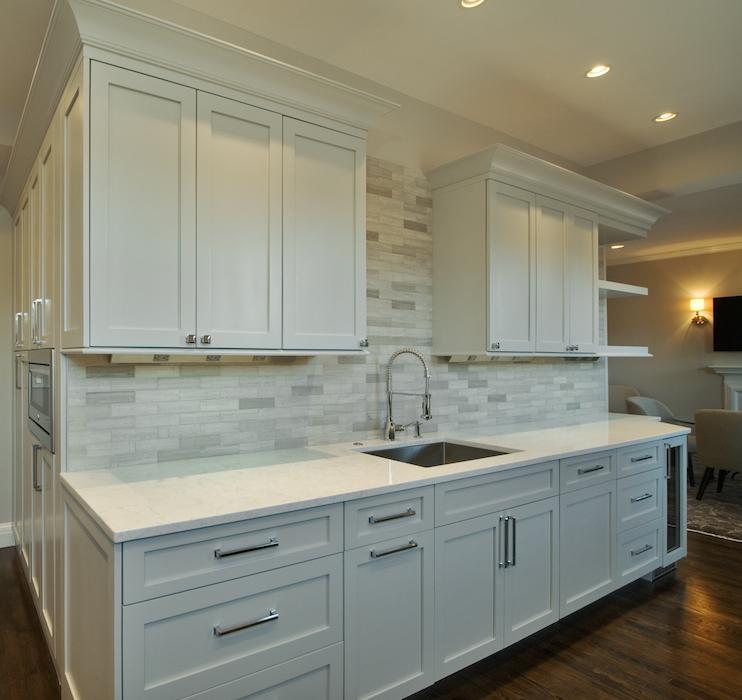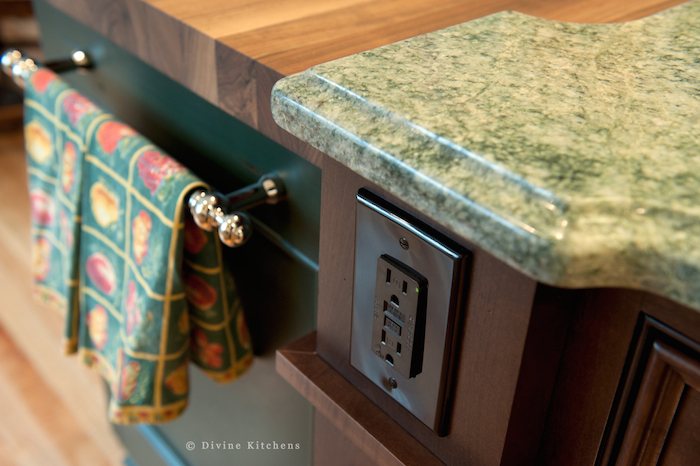A Short Guide To Outlets In Your Kitchen
If you are planning for a kitchen remodel, big trends tend to take the drivers seat for design and planning. When planning big picture design, electrical outlets should be carefully planned & placed with thought and purpose. Your kitchen is an electrical outlet hub that has various needs for different tasks. From major appliances to small appliances, to lighting, exhaust fans & built-in appliances, each has their own space restrictions and needs that need to be thoughtfully planned out. A place to charge and store your phone or tablet might be a high priority, or perhaps a small electric hub that holds your coffee pot, juicer & blender is a must.
Between electric codes, aesthetics, placement and more, we are here to help break down your questions and concerns to create a perfectly groomed space that meets all of your electrical needs.
Introduction to Electrical Outlets
The first step to outlet success is understanding residential wiring requirements. The National Electric Code requires the following parameters for safety and efficiency in your kitchen:
- Any countertop wider than one foot requires a receptacle outlet
- Receptacle outlets must be installed every four linear feet--more is acceptable but less will get you in hot water
- Countertops separated by range cook top, refrigerator, or sinks are considered separate countertop spaces
- Small appliance circuits feeding countertop receptacle outlets are required to be Ground Fault Circuit Interrupter (GFCI) protected
Types of Electrical Outlets
Before choosing outlets, it’s important to understand a few basics about the electrical wiring in your home. Most homes in the U.S.A. are wired with a combination of 20-amp, 15-amp & 120-volt circuits. 15-amp are the most common outlets & you'll recognize them as the outlet you plug your favorite lamp into.
15-amp receptacles can be used with 20-amp circuits, so most of the outlets are a standard 15-amp with two slots and a u-shaped grounding hold. Appliances such as microwaves usually have a 20-amp plug and thus must be plugged into a 20-amp outlet. 15-amp plugs can be safely plugged into 20-amp outlets, but 20-amp plugs will not fit into 15-amp outlets. Your electrician can help you sort through your electrical needs, but it always helps to have a basic understanding for your own safety.
Outlet Location & Design
Depending on your needs, we have a few creative solutions to install outlets so they are right where you need them, when you need them. What ideas do you think you'll incorporate into your remodel?
Installing a power strip under your upper cabinets will not only meet code requirements, but will also put that plug within reach for any shape appliance that comes it's way. Below, we seamlessly installed two power strips to compliment the light marble backsplash.

Although it may sound like a given, it's important to install outlets where you know you'll need them. Do you work at your kitchen island for most food preparation? Put a few perfectly placed outlets along the island to be there at your beckon call. A pop-up outlet can be a great way to tie in functionality and wow your guests at the same time!

Install the outlets or switches on or within your cabinets for a well tailored and streamlined look. With a little planning, this can be the perfect way to place a necessity in the kitchen without compromising style.


Pick outlet and switch plate covers to coordinate with your material selections & you'll turn your plugs from an unsightly fixture into a design element. Below we matched the outlets to a cool gray glass tile & love how it doesn't take away from the simple design the homeowners were aiming for.

Helpful Questions
- What kind of lighting do you want in your kitchen and how will that shape where your outlets are placed?
- Do you want ceiling lighting? Recessed? Surface Mount? Ceiling Fan? Under the cabinet lighting?
- What portable appliances do you plan to have in your kitchen? What are their power & location requirements?
- Do you have any special requirements or needs due to a disability or any special modifications that should be considered in the design and location of electrical outlets?
- Where do you want light switches & what kind of lighting controls do you want?
Start to work through these points with your electrician to help pave the way to answer questions of what style, location & needs you have. By narrowing in on the basic needs, the rest of the project will fall together and you'll be more than satisfied with that perfectly placed outlet.
